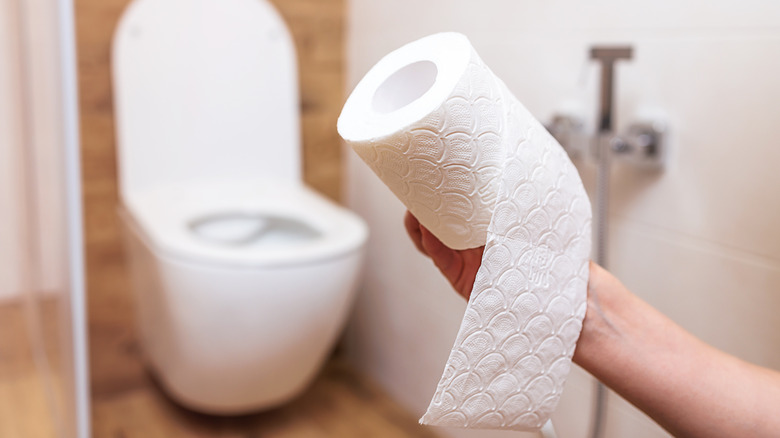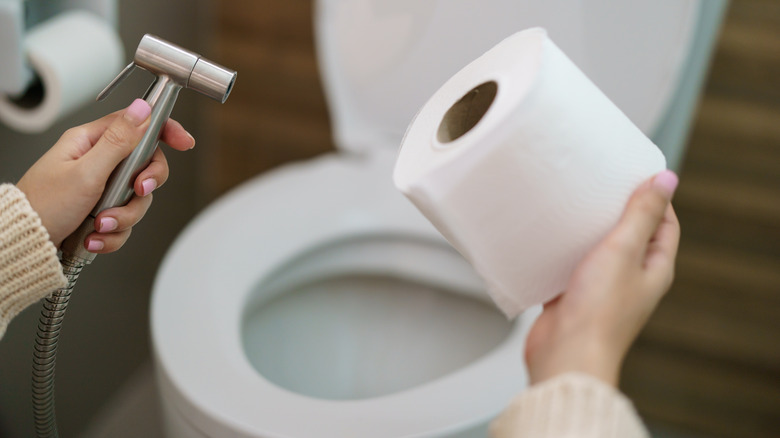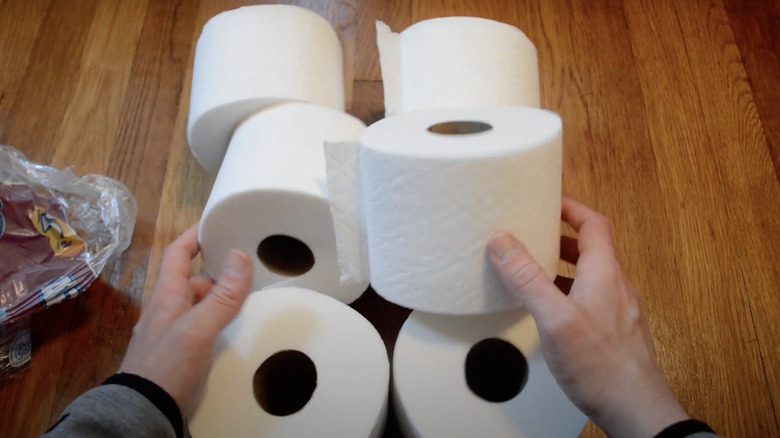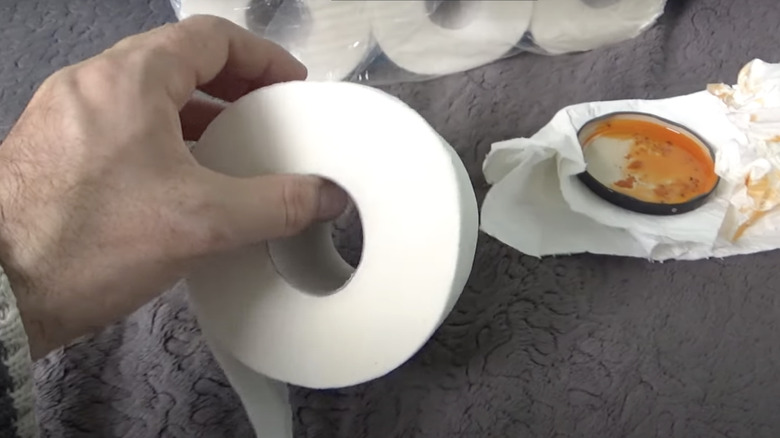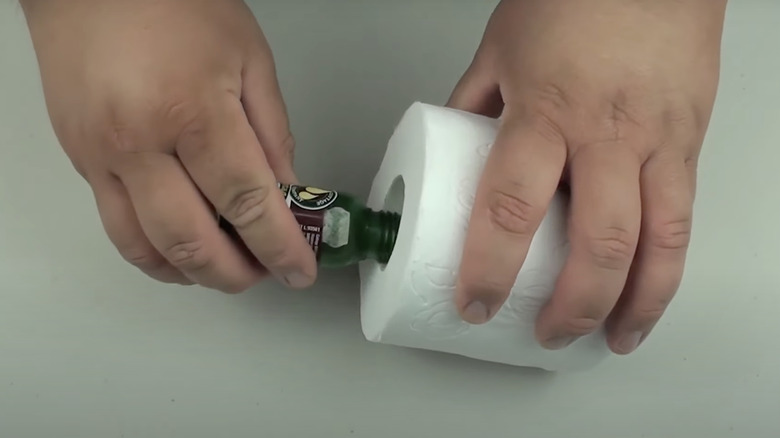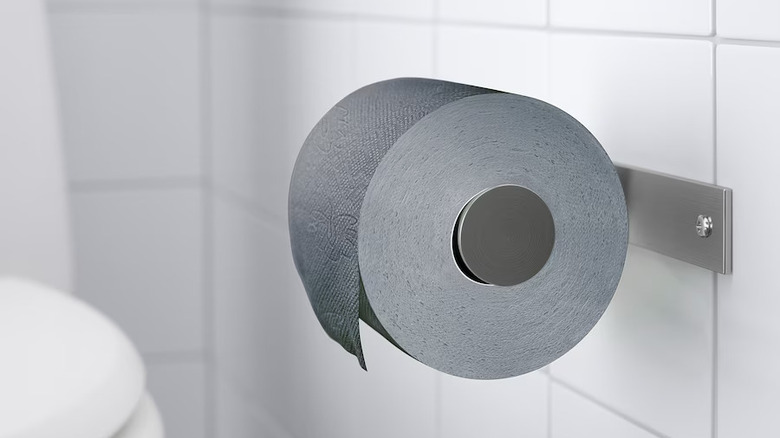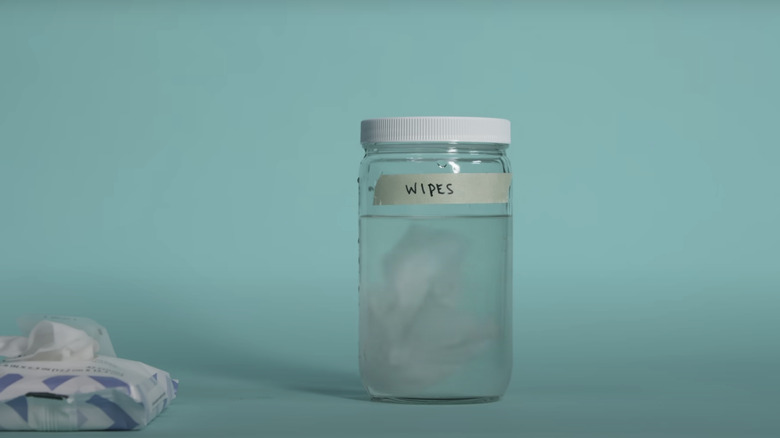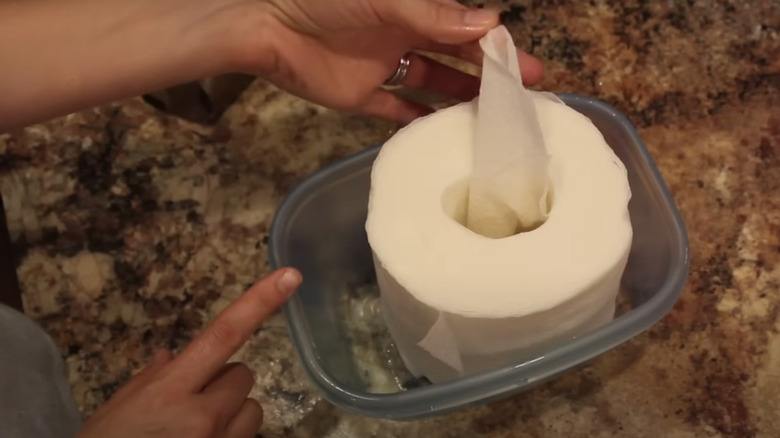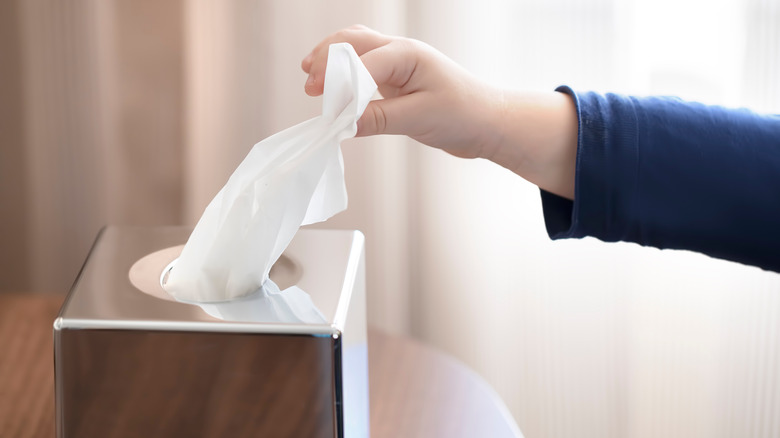Avoid Using These Toilet Papers If You Want To Keep Your Septic Tank Healthy
Originally penned as "Medicated Paper for the Water-Closet," the first patented toilet paper became commonplace in the late 1800s, and modern society has relied on this invention ever since (via Cottonelle). Even hundreds of years later, you'd be hard-pressed to find a household without spare rolls of toilet paper, as even the most frugal individuals consider it a necessity. Seeing as it's a centuries-old product with no signs of going out of style, it's unsurprising that companies have found many ways to capitalize on toilet paper over the years. Throughout the 1900s, new toilet paper trends like multi-ply, colored, perfumed, and softer sheets were advertised to the public. However, with the introduction of many of these toilet paper innovations also came unprecedented septic system issues.
Homes that aren't on a city sewer are outfitted with septic pipelines, tanks, and drain fields, which break down solids in wastewater, removing them from your home. This system relies on a bacterial ecosystem, which thrives in the main tank by breaking down organic waste and "flushable" toilet products. This system is ingenious when households are careful about their flushing habits. Unfortunately, many of the re-formulated toilet papers aren't as safe for your septic system as you've been led to believe.
Soft toilet paper is plush to the touch but more likely to cause clogs
When perusing the aisles at your local superstore or grocery store, the softest toilet papers always have the most luxurious appeal. Sold under names like "Comfort Plus," "Extra Soft," "Extra Plush," "Ultra Soft," and "Ultra Plush," these toilet paper options often advertise that they are designed for comfort and are more absorbent than their standard counterparts. Many popular toilet paper companies like Charmin, Angel Soft, and even generic brands sell these two-ply rolls with multiple layers of plush paper.
As appealing as these extravagant options may seem, they aren't doing your septic system any favors. Soft toilet paper varieties are made from fresh wood pulp from hardwood and softwood trees, like most traditional toilet paper types. However, the wood pulp is also treated with mineral oils and paraffin, and double or triple-layered to make a thick and chemically-infused roll that prioritizes temporary comfort. The thickness and additional chemical properties of the paper mean you're flushing more products down your pipelines.
As you already know, bacteria is responsible for breaking down the remaining cellulose fibers that don't disintegrate in the water. Therefore, when you flush extra soft toilet paper, you're creating waste faster than it can be broken down. Many of the people that rely on soft or plush toilet paper do so because they have sensitive skin. You can always invest in a bidet to do the majority of the cleaning, so you only have to use a minimal amount of this luxurious toilet paper.
Strong toilet paper is reliable but complex to dissolve
Soft toilet paper's closest relative is "Ultra-Strong," which has a similar downfall to the aforementioned plush varieties. A top toilet paper company literally advertises this type as being "4 times stronger when wet." Although this may have an industrial appeal, it doesn't have promising connotations for your home septic system.
The idea behind extra strong toilet paper is that it takes fewer sheets to clean yourself since they are two-ply thick and woven in a complex quilted texture. This makes them harder to unravel and more resilient to moisture, making them more absorbent. In reality, these toilet papers are only septic-safe when used as intended, which is minimal. If your household members are unrolling multiple sheets during each bathroom break throughout the day, this extra thick toilet paper will slowly back up your septic system. This paper is also best utilized concertedly with a bidet, so minimal tissues are used and flushed.
3-ply toilet paper triples the amount of paper you flush
Since regularly using 2-ply toilet paper can lead to septic issues, it's no surprise that 3-ply toilet paper comes with many of the same risks. A step above plush and strong toilet papers, 3-ply toilet paper rolls are three times the size of a standard roll. They often boast of having both strength and comfort and are designed with quilted weaving that makes them especially durable and soft. This type of paper isn't as popular as 1- or 2-ply types, and depending on where you live and whether there's any demand, it may be difficult to come across.
Although many people love to splurge on superior toilet paper brands, there is a limit to what people are willing to spend. Since 3-ply packs are uncommon and contain more materials, smaller packages sell for higher prices. In addition to a high price point, these products are known to cause septic clogs if they aren't used with some consideration and moderation. In other words, if you have younger children or household members who use liberal amounts of toilet paper, you're setting yourself up for a backed-up system.
If you're one of those people who prefers the finer things in life, you can still use triple-strength paper. Just keep in mind that you won't need as many sheets and should limit how many you pull when doing your business. As mentioned previously, the less risky route is investing in a lower-ply paper that is more easily disintegrated by water.
Scented toilet papers smell nice until they disrupt your septic ecosystem
Since toilet paper is used for unpleasant tasks, it's unsurprising that brands have tried to find ways to make this product more appealing to the masses. One of these approaches is to coat the papers in floral-scented essential oils, such as lilac and lavender. The fresh odor leaves your toilet and lower regions smelling far unlike your recent activities, but it comes at a cost. By using this type of paper, many people suffer from skin afflictions since the fragrant chemicals irritate sensitive skin around private body parts. None of these scented oils are overly dangerous on their own, as they include ingredients and compounds like alcohols, esters, and aldehydes, but they can cause dermatitis, rashes, and skin abrasions on sensitive skin.
If these chemicals are harmful to our skin, you don't want to imagine what they're doing to your septic tank. Remember, that any additional chemicals can harm the bacterial ecosystem that breaks down waste and toilet paper in your home sewage. Flushing alcohol, bleach, and aldehyde-coated paper products kills bacteria and increases your risk of a backed-up septic tank later down the road.
Instead of using scented toilet paper to freshen up after using the bathroom, you can rely on other methods. Once again, you may want to consider a bidet, which will freshen up your extremities using fresh, clean water. If you're worried about any smells you leave behind, you can use essential oils, potpourri, wax melts, candles, and other room fresheners (that don't spray directly into your toilet) to help mask any residual odors.
Dyed toilet paper is fun and colorful but adds unnecessary chemicals
Colorfully-dyed toilet paper is the equally harmful sibling to scented toilet paper. Instead of chemical-infused fragrants, it has chemical infused-dyes. Whether completely colored in a solid shade or emblazed with a printed novelty image, these paper sheets are decorated with additional chemicals that aren't good for your body or septic system. This is likely why colored toilet paper has gone out of style for the most part, and it's difficult to track down among the many bleach-white options.
You might wonder why toilet paper is white in the first place. Usually, such vibrant shades of white indicate that companies are bleaching their products for aesthetic purposes, but this sterile color is actually toilet paper's natural shade. Toilet paper is created from wood pulp, which is then treated with hydrogen peroxide and chlorine. This bleaching process removes lignin, a natural material in wood pulp, to soften paper for human use. Cellulose fibers also turn white throughout this process, giving toilet paper its soft bleached composition for complication-free wiping and flushing.
As mentioned previously, the fewer chemicals used to treat toilet paper, the less harmful it is to the bacteria in your septic system. Changing the toilet paper to any other color requires dyes and inks. Instead of using colorful toilet paper to elevate your bathroom's interior design, consider adding exciting hues through decorations that don't touch your nether regions.
Flushable wipes help you feel clean but have hidden additives
When shopping for toilet paper, you'll often find flushable wipes in the same aisle or in close proximity. Despite what their name might imply, these moisturizing paper wipes aren't as easygoing as they might seem. These moist toilet tissues are toilet paper products with aloe, vitamin E, Polysorbate 20, Disodium phosphate, and other additives that make them refreshing and appealing to consumers. They may advertise being flushable, but it's important that you take a look at their base qualities that contradict this claim if you're on a septic system.
For starters, sodium benzoate is added to these wipes to prevent the growth and reproduction of bacteria on your own body. While this may succeed in keeping you physically healthy and clean, common sense dictates that you shouldn't flush this down your septic system where healthy bacterial ecosystems are vital. Flushable wipes also contain Polysorbate 20 and Disodium phosphate, which are chemicals that help retain the wipes' composition inside their packaging. These additive agents keep the wipes moisturized and in one piece, so they don't break apart while you're using them. Although this may be useful from a functional standpoint, you should think about what this means after they've been flushed.
They're built to eventually break down in your septic system, but they do so much slower than traditional toilet paper due to these additives. On a final note, these wipes are used alongside normal toilet paper, meaning you're putting twice as many paper products in your toilet. This creates more work for your septic tank, both quantity- and complexity-wise.
If you stand by your use of moisturizing toilet paper and don't want to omit this product from your daily life, luckily, there are septic-safe alternatives out there. Consider a toilet paper spray, such as the product featured on the TV show "Shark Tank." Pristine toilet paper spray is sprayed directly onto standard toilet paper, giving you a moisturized experience that is far less foreboding than flushable wipes.
Baby wipes are gentle on skin not septic systems
Baby wipes are closely related to flushable wipes, with a few material differences that make them even less flushable. These pre-moistened products aren't made with dissolvable paper; they usually contain fabrics and plastics, with added detergents and chemicals that make them a septic system nightmare. Many people mistakenly believe that baby wipes can be flushed alongside toilet paper because they're used for a similar purpose. However, with their cotton, rayon, polyester, and plastic composition, these wipes wouldn't be flushable even in their base form. None of these products break apart in water, causing them to quickly clog plumbing lines. If they do somehow make it through the pipes and into your septic system, the moisturizing and antibacterial chemicals will prove fatal to the septic tank bacteria.
Whether you use baby wipes for your own needs or to take care of a young child, you should always throw them in the garbage and not down your toilet. If you're looking for an eco-friendly alternative to disposable wipes, there are plenty of reusable cloth options sold online and in local stores. Combining reusable cloths with antibacterial creams and warm water provides the same advantages as using baby wipes without the waste.
Facial tissues are soft and lightweight until wet
Tissues are even more lightweight than toilet paper, and their feathery feel creates the natural assumption that they're safe to flush down your toilet. This belief is incorrect. Tissues are made for standard trash disposal, not septic tanks. They are often manufactured with biodegradable cellulose fibers, similar to toilet paper. Although they are made from similar wood fibers and wood pulp, tissues have additives that make them resilient for other purposes, like blowing your nose and cleaning up small spills.
These additives do not break down when they come in contact with water, making them unsuitable for toilet disposal. Instead, they are highly absorbent, causing them to retain large amounts of moisture and clog bathroom facilities. In fact, top tissue brands, such as Kleenex, warn the public that their facial tissues are not designed or tested for flushing. They should always be tossed into the garbage rather than your toilet.
